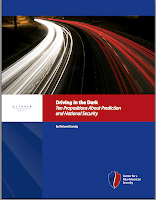
It's still in beta, and not all the data are loaded yet, but even so the website
Mapping Gothic France, put together by art historians Stephen Murray of Columbia and Andrew Tallon of Vassar, is amazing. The home page maps the Gothic cathedrals of France, and provides a link to an arch design simulator - you can stretch a Romenesque arch into a Gothic one. There are animated maps showing the spread of Gothic architecture, and links to essays in called "Stories of Gothic."
For each cathedral, the site includes plans, elevations, timelines, a history and chronology, and a monograph. And photos, many high quality, high resolution photos. (The Columbia
Record reports that the project used both a 40 megapixel camera, and a gigapixel camera.) The photo is a screenshot from a panoramic view from the center of the Cathedrale Notre-Dame in Chartres.
Each cathedral also gets a series of plans, from crypt to roof, with images and panoramic photos clickable on the diagram. Here's a screenshot of the Chartres ground level plan:
(NB: It's a screenshot, so you can't click on it here, but go to the site.)
You can also compare the cathedrals by their various schematics, including nave heights, aisle heights, or floorplans. Here is a screenshot of the parametric sections, sorted by nave height (that's the red figures, too small to see here, though not on the site). There are three stacking options, depending on how you want to look at the photos or data.
The site does more: it allows a viewer to compare the facades of different cathedrals. You can look at groups from different parts of the country. There are definitions of architectural terms. Altogether, it's an impressive way to think about storing and displaying a huge amount of information that exists in different forms.
If you're looking for your favorite cathedral, you may have to wait a bit - Albi's information is partly loaded, Conques and Avignon are not, yet. Surfing the site is not quite a visit to France, but definitely spend some time on it if you're planning a trip. If you're not, it's still a fascinating way to spend a couple of
hours days.
Thanks to Dan Richman for telling me about Mapping Gothic France.










